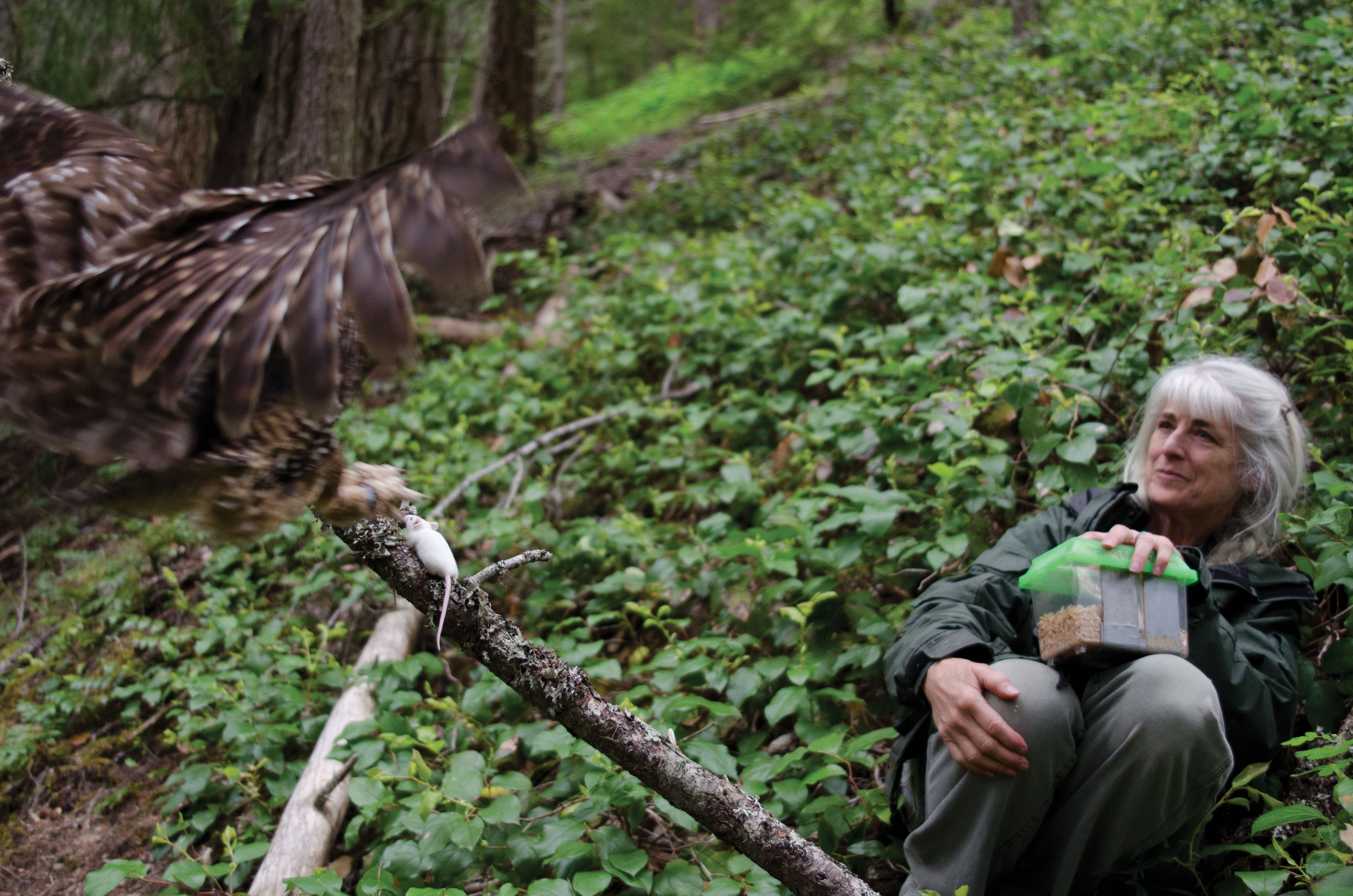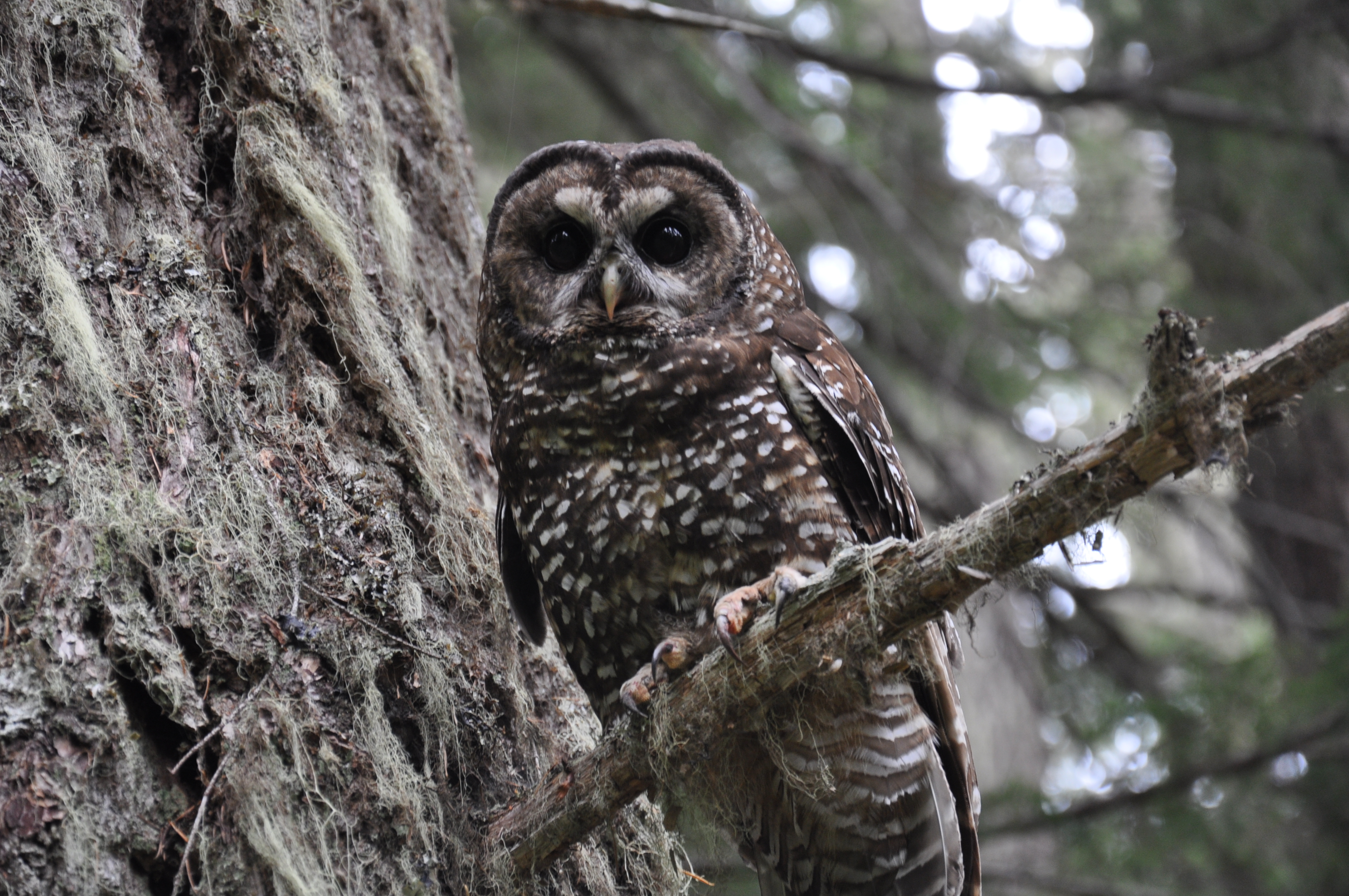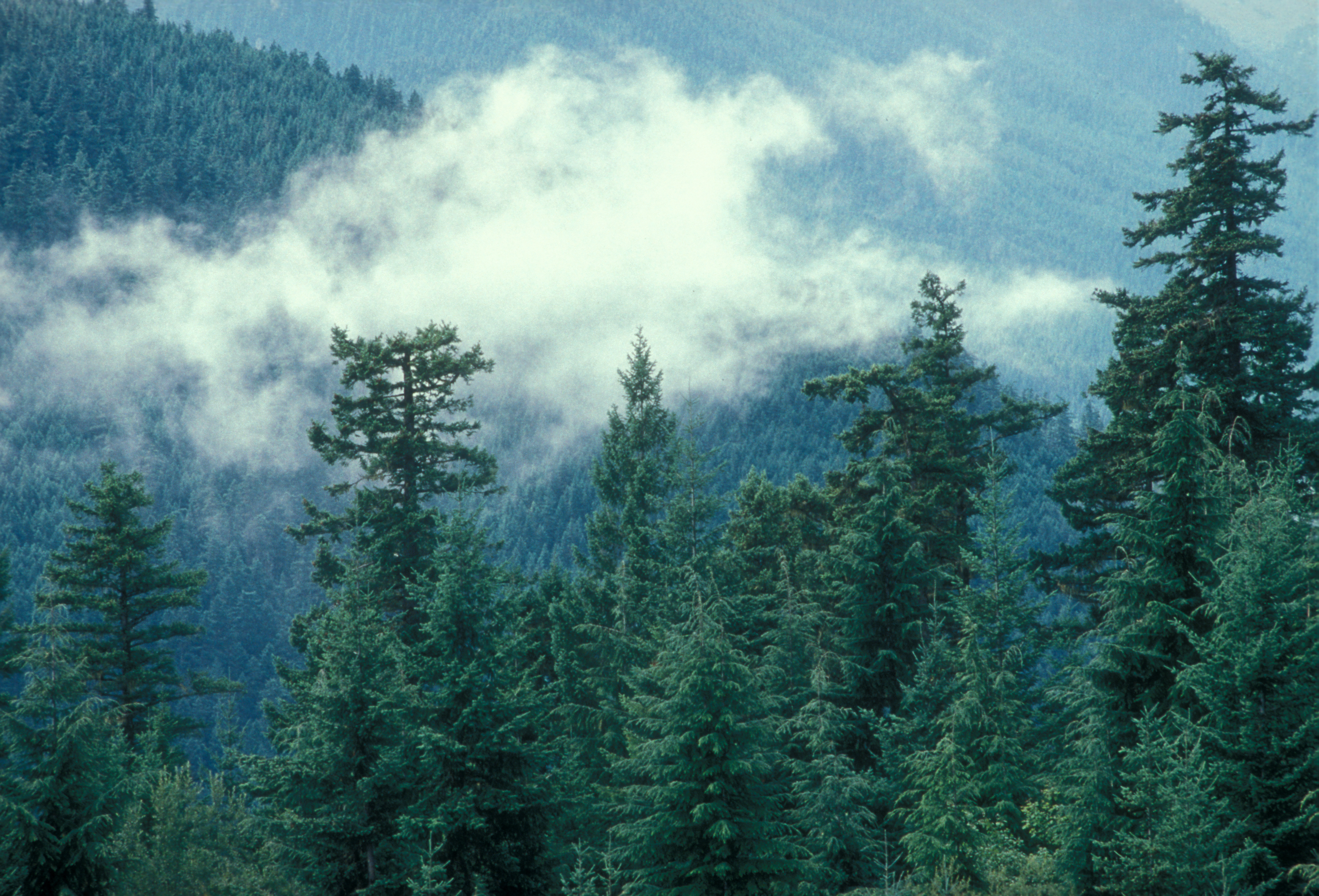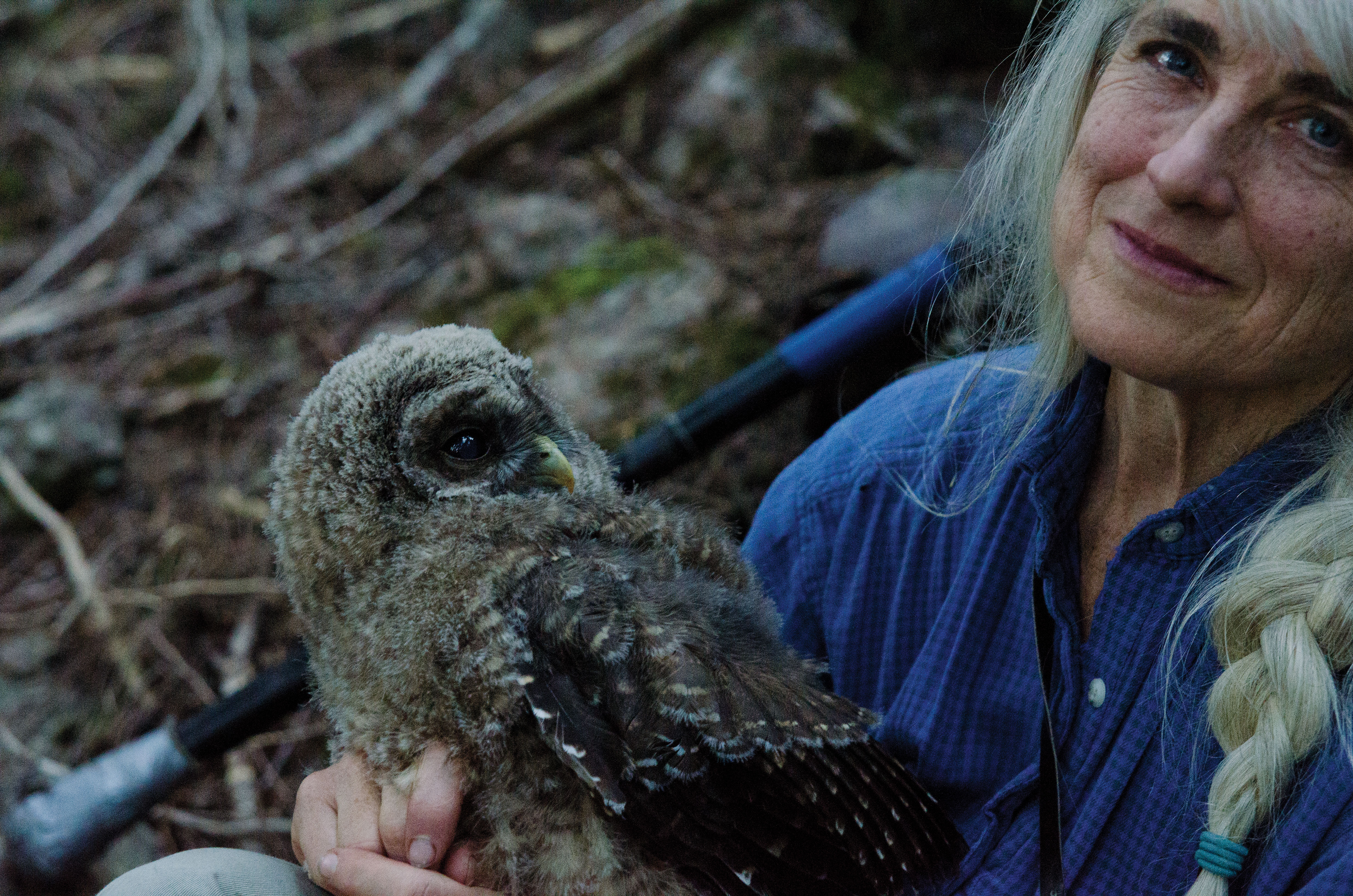One researcher’s work to protect the spotted owl throughout Washington State’s Olympic Peninsula
By Betsy Howell
The medium-sized owl with the spotted breast and big, chocolate eyes arrives without a sound. Feathers on the leading edges of its wings are broken up by small serrations that allow air to quietly flow through rather than over the top, which creates turbulence, or noise. This silent flight is the bird’s key to successful hunting, or to remaining invisible for other reasons. However, this female northern spotted owl now perched above me and Debaran Kelso, a researcher with a long-term owl demography study on Washington State’s Olympic Peninsula, has come immediately to Kelso’s soft hoots.
“Last week,” Kelso tells me, as she grabs a mouse she has brought to feed the bird, “I found the female and two owlets. One owlet was dead at the base of the nest tree, likely from accidentally being bumped off the too-small nest platform. The other owlet was still perched in the branches of the nest tree.” She adds worriedly, looking around, “I don’t see the survivor yet.”
The first mouse is quickly eaten by the female. During the next half hour, the bird caches another two proffered mice in the upper canopy for later meals. She makes no attempt to call to her remaining young, or to take the mice to it. None of these are good signs, yet Kelso says she’s been fooled before.
“If she has just fed the owlet, it may not be interested in any more mice from me, so it might not call to be fed. However, generally, she makes at least some attempt to show the prey to her young.”
Sunlight filters through the forest above us in a kaleidoscope of shapes and yellowish hues. This particular stand is almost 300 years old and had a fire rage through it more than a century ago. The trees are not classically large, being on average 30 to 40 inches in diameter, and fairly uniform in appearance. Consequently, the owls’ nest is in an unlikely tree, an even smaller 23-inch diameter Douglas-fir where the top had broken off and created a small shelf. In subsequent years, new tops grew up around this shelf, providing at least some protection for the site. It’s not a very protected residence against predators or the Olympic Peninsula’s rainy spring weather.
We spend the next few hours searching for the owlet. Unfortunately, we find nothing to indicate its demise or continued survival. The female follows us for awhile, perhaps expecting more mice, then vanishes back into the forest. She hasn’t called once, and her leaving is as undramatic as her arrival. In the early days of spotted owl research, the birds’ willingness to answer human vocalizations, in addition to their lack of wariness, made them a relatively easy animal to study. However, more than three decades after intensive study of northern spotted owls began, the game has changed. In Kelso’s study area, the birds have become quieter over the years, their comings and goings during surveys less predictable. This has possibly occurred in response to now having to share space with their more aggressive cousin, the barred owl.
“Sometimes,” Kelso says, “I’ll see a sign, either pellets or prey remains, and I’ll know they’re here, yet I’ll call and call without any answer. I can search all around their nest tree and roost trees, but won’t see them anywhere. Eventually, I just have to wait for them to either fly in or call and give their location away.”
Debaran Kelso has been studying northern spotted owls (Strix occidentalis caurina) since 1987. Many biologists, including myself, began careers with the U.S. Forest Service on spotted owl survey teams, though few of us continued with the rigorous night work year after year. In the late 1980s, the conflict over how to manage Pacific Northwest forests was at its peak, and tensions ran high between the environmental community, the timber industry and land managers.
“It was a bit unnerving,” Kelso recalls of her early work on the Olympic Peninsula. “We’d be leaving the woods at 3:00 a.m. from a night of surveying, and the log trucks would be going in. They
all knew, of course, why we were out there. I never told anyone what I did.”
The stories of anti-owl sentiment are well known in the Northwest: rubber chickens tied to posts with “spotted owl” written across their bodies; bumper stickers that read, “I love spotted owls…fried;” and boxes of “Spotted Owl Helper” for sale in the restaurants of small, logging towns (still available in 2015 in some places). Yet, for all that, Kelso wasn’t deterred.
“I took the job initially because that’s where the funding was,” she says. “However, I quickly fell in love with the owls. There aren’t many wildlife species that are so curious about humans and aren’t actively distressed in our presence. There also was an element of urgency in finding the birds and protecting them and their habitat that wasn’t there with other species.”
As the seasons went by, her affection grew. In 1990, the owl was listed as a federally threatened species, and in 1992, after having been on other owl crews, Kelso began working on the demography study, an effort focused on monitoring population trends of the species on federal lands. The demography work takes place in 11 study areas across the owl’s range, including three in Washington State: the Olympic Mountains, Mt. Rainer National Park and the Cascade Range near Cle Elum, a small, but growing city along Interstate 90. Throughout the ’90s, Kelso, in conjunction with other researchers working on the study, found and banded birds in Olympic National Forest, a rough doughnut of land that surrounds Olympic National Park. As she became more a part of the owls’ world, the Northwest Forest Plan came into existence. This document, finalized in 1994 under President Bill Clinton, became the overarching guide for management of National Forests within the range of the owl. With the adoption of the Plan, most of the Olympic National Forest was designated “Late-Successional Reserve,” where the primary emphasis would be maintenance of older forest habitats. This change resulted in drastically reduced levels of old-growth timber harvest on federal lands. In that sense, the species has been helped tremendously. However, the scientific and management communities didn’t foresee the dramatic role that barred owls would play in the recovery of spotted owls.
Finding a barred owl in the 1980s was considered a novelty, says Kelso. They would respond to a surveyor’s hoots just as readily as spotteds, and they look quite similar, the main differences being a slightly larger size, striped breast and white barring on the back of the head. However, behaviorally, they are quite distinct. Barred owls are far more wary of humans, and their scientific name, Strix varia, reflects the diversity in their diet and habitats occupied. Once a resident of only the eastern United States, the barred owl has expanded its range westward in numbers and speed matched only by similar movements of European migrants in the 19th and early 20th centuries. In fact, the creation by western settlers of small forested patches around homesteads and towns across the prairie, as well as the suppression of fires that helped maintain the plains’ ecosystem, may have been partially responsible for making the landscape more appealing to the generalist barred.
“Barred owls are cool birds,” says Kelso, “and it is a wondrous thing to see them. But, they are having a devastating impact on spotted owls.”
Debaran Kelso is a bit owl-like herself. She admits to having become rather reclusive over the years and remains largely nocturnal even when not surveying. Her home is a “tree house for adults,” as she describes the four-story, cedar building nestled in a second-growth stand of Douglas-fir, madrone and western hemlock. On the top floor, you’re eye level with the birds of the forest canopy: robins, warblers and kinglets that fly, nest and forage all a few feet away. Kelso has lived in many places, including Alaska, Chile, Mexico, England and Namibia, and she did her undergraduate work at the University of Colorado, where she began as a psychology major before switching to ecology.
“I’m really intrigued by people,” she says, “but I also loved animals and loved being outdoors. The question was could I make a living in the environmental field? In the end, I just decided to do what I loved best.”
That end took her to Alaska and research projects studying wolves and wolverines, as well as Pilanesburg National Park in Southern Africa, where she completed a master’s degree looking at resource partitioning in eland and kudu. Yet, by 1986, Kelso was tired of having her life tucked away in boxes; she wanted to find a home. With friends in Washington State, she made her way to the Olympic Peninsula in the spring of 1987.
Apart from Eric Forsman, a well-known U.S. Forest Service research biologist who began studying spotted owls in the 1960s and has served as the research lead for four of the demography studies, few have worked with the species as long as Kelso. She has seen many changes over the years and has come to know individual owls well. Each bird that she finds, she marks with a unique set of leg bands for later identification. At a different territory I visited with Kelso, we searched for a pair originally banded in 1996. This female, now more than 18 years old, is very reliable and, if
around, will come to Kelso’s calls. The male, a new mate for the female and only just banded in 2014, has been more wary.
We didn’t find either bird on this day.
In another area, Kelso found a pair in 2005 and banded both the female and male. The next year, she didn’t find them, and the following year was the same. Not until 2013 did both of the same birds reappear. In 2014, the pair successfully fledged two owlets. For eight years, the owls had disappeared, or so it seemed. Generally, in wildlife research, failing to find an animal doesn’t prove its absence, and obviously these birds were not entirely gone, however, where they were during that period is anybody’s guess. Given Kelso’s familiarity with the species and the landscape, she would have the best insight of anyone.
“Where were they?” she shrugs. “I have no idea.”
In 2015, in addition to the Northwest Forest Plan coming up for revision, the U.S. Fish & Wildlife Service will also begin a review to consider upgrading the spotted owl’s federal listing status from threatened to endangered. During this time, much new scientific information about the species will be considered. Apart from the demographic data and the effects of the barred owl, the long-term demography studies have also yielded new insights into how long spotted owls live. Earlier estimates placed an owl’s life span in the wild at approximately 15 years or less; now, it’s known they can live over 20 years. The oldest animal Kelso knew was a male she banded in 1991 as a juvenile. She found this bird most years in its territory, but the last time she saw him was in 2012. The following season, the female was alone. In 2014, the old female was gone as well, and a new pair had arrived in the area.
“The new birds were much sneakier than the old pair,” Kelso explains. “There was a lot of evidence they were around, but they wouldn’t respond to my calls. Finally, I saw the male flying. After catching him later in the season, he turned out to be a juvenile I’d banded in 2004 at a site four miles to the north. I hadn’t seen him in ten years.”
Kelso acknowledges the general, grim consensus that researchers are documenting the demise of the northern spotted owl species. Yet, she also remains hopeful. The birds are doing better in some parts of Olympic National Forest, and perhaps they can survive in certain refuges. Additionally, she’s seen the owls return to sites and observed their behavior change in ways that may be aiding their survival. In areas where barred owls have been experimentally removed in northern California, spotteds have returned to historic nest trees and territories. Whether a two-tiered management strategy of barred owl removal (which is not yet proposed for the Olympic Peninsula) and older forest preservation can buy enough time for spotted owls to recover is uncertain.
“There are many questions,” Kelso admits, “and the landscape is vast. When I can’t find the birds, I can search their favorite places, but if they aren’t vocalizing…” she shakes her head. “Well, they melt right into the trees, and you’ll never see them.”
Kelso returned twice more in 2014 to the site where we searched for the owlet, but found nothing. Either it had died like its sibling, or it was already learning that survival depended on a silence as deep and as old as the forest itself.
Betsy Howell is a wildlife biologist with the Forest Service currently working in Olympic National Forest in Washington State.




